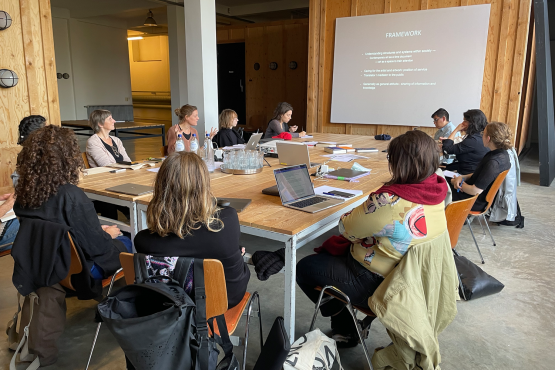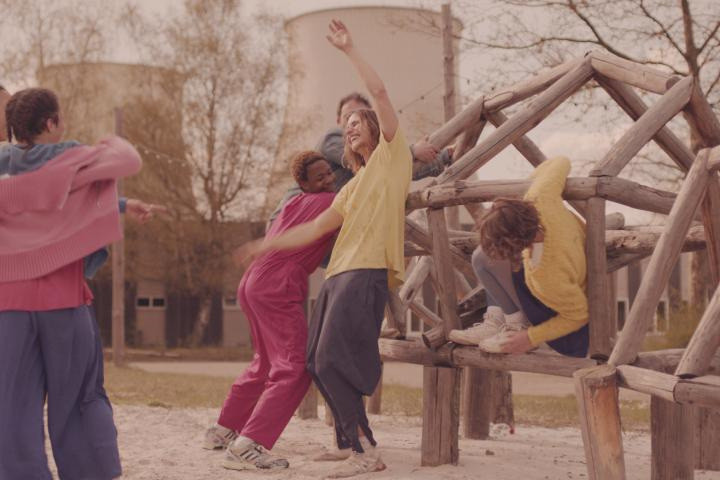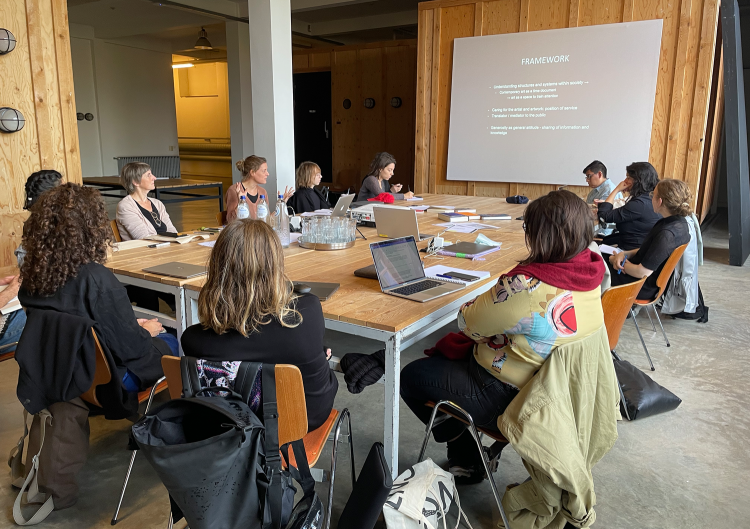
Masterclass: Ecstacy
with Karen Verschooren and guests
20–22.10.2021
STUK House for Dance, Image and Sound, Leuven
From 20 to 22.10.2021, STUK House for Dance, Image and Sound welcomed the Curatorial Studies programme of KASK for a co-organised masterclass about ‘the ecstatic being’. Lectures and talks with scholars, practitioners, and artists introduced the possible definitions and manifestations of the ecstatic. The Curatorial Studies participants gathered around the table to create a curatorial proposition around this theme, based on the lectures and conversations with the guest speakers. The results of this masterclass will be considered in the curatorial framework for the Artefact exhibition, taking place in February 2023. More than just a topical exploration, the masterclass provided a hands-on experience with the first research stages of creating an exhibition. Together, the participants discovered the pitfalls and possibilities of making an exhibition around such a broad topic. What is the ‘ecstatic’? What specific topics can be distilled from this concept? How can you create a curatorial framework receptive to societal discussions and artistically enriching?
In her introduction, curator Karen Verschooren explained the context of STUK and the concept of the yearly Artefact exhibition. The practical framework in which she must work for each edition of Artefact was included in the masterclass assignment. The students had to equally consider the short duration of the exhibition, the available spaces, the context of STUK with a parallel performing arts program during the exhibition, and the number of participating artists and works on commission in their final curatorial pitch. The general theme for the masterclass is a broad concept with a vast array of related notions and domains. Therefore, Verschooren first shared her own early interpretation of the theme, which germinated from the previous editions of Artefact. She approached the ecstatic as an experience that implies different ways of being in the world and activating bodily knowledge. During the masterclass, the ecstatic was explored further in several ways: from theory to practice, through philosophy, spirituality, and art.
Firstly, philosopher Stéphane Symons provided a theoretical foundation to the subject by looking into the perception of the ecstatic in Western philosophy. Can the ecstatic be the subject of philosophy, and should it be? Symons argued that the ecstatic was mostly described as a negative or chaotic experience, as Western philosophy fundamentally searches for systematic order in what constitutes life. He defined the ecstatic through the lens of respectively metaphysics, epistemology, anthropology, and politics. These four domains in philosophical thinking were used as four pillars to structure his argument. In his conclusion, he defined the ecstatic as a capacity for change through a transformative experience, in which a certain boundary or limit is crossed. Therefore, the ecstatic should be part of philosophy in different domains because the global society we maintain today is in desperate need of change and should employ every tool to create and capture transgressive energies. This lecture proved to be an important foundation for the students to see the theme from a structured point of view and made it easier to discern different elements or implications of the ecstatic. The ecstatic seems to be a capacity, rather than an experience, which could be individual or collective.
Secondly, the ecstatic was presented from the point of view of Zen Buddhist practitioner and former monk, Tom Hannes. From this conversation, it becomes clear how the philosophical interpretation of the ecstatic as a transgressive capacity also coincides with its occurrence in spiritual practices. Ecstasy is not just one experience; it is rather a historical way of thinking about what it means to have a meaningful life. From a Buddhist perspective, one practices meditation every day to create an ecstatic experience that lasts throughout your life and is not a temporary high. Tom Hannes adds his own interesting perspective to the mix by explaining the axial perspective on the history of our civilization and by criticizing the Atman-Brahman axiology in traditional Buddhism, in which the act of meditation revolves around the reaching of the All in the form of Nirvana. However, according to him, the ecstatic experience of meditation is its transgressive potential to make you see things from a new perspective, with more mindfulness and gratitude, with more kindness and love. To explain this, Hannes introduces the concept of ‘the interface self’. That self is not so much one’s true inner core but is a mode of dealing with the interaction between what is inside and what is outside. Through meditation, you can become porous and relational towards everything around you. This approach could help us to understand and appreciate life and the world in a more ecological and healthy way.
Thirdly, the students were introduced to artists Shana Moulton and Grace Ndiritu, who have touched upon the subject of the ecstatic in their practices in different ways. Shana Moulton’s film series Whispering Pines presents the adventures of Cynthia, the alter ego of the artist. Cynthia represents the good American woman, trapped in her kitsch aesthetic and the banality of life. She is looking for a transgressive experience. In this adventure, she is guided by her mediators: an angel and a shaman. She uses crystals, meditation, yoga, etc., trying to find more meaning in ecstatic experiences through mindfulness and contemporary witchcraft. In Whispering Pines 10, the screened film during the masterclass, Cynthia splits and shatters into pieces after she dreams about having a bigger existential purpose (saving the earth). These scenes visualize the idea that ecstasy is a form of becoming, not to be ‘something else', but to cross a liminality towards something in the process. Moulton explained more about her work during a Q&A. Grace Ndiritu’s introduced three projects, with a special focus on her latest video ‘Becoming Plants’. First, she introduced her projects Healing the Museum and COVERSLUT, in which she respectively tightens the screws of the political and social responsibilities of museums (specifically ethnographic museums) and the fashion industry. In Becoming Plants, her most recent work, the artist filmed a performance about controlled psychedelic drug intake. The performers took a very controlled and small amount of a specific mushroom, and the artist filmed the results in a specific location. The voice-over of a conversation with a psychotherapist explains the science of how our brain works, something we still know very little about. Ndiritu differentiates a state of bliss, which is immediate and immanent, from the ecstatic experience, which is more durational in the sense that it opens the world to you in a different way. Yet again the important idea that the ecstatic is a transgressive capacity rather than a short-lived experience is underlined, this time through the lens of art.
Finally, the students were invited to explore the topic departing from the lectures and their own points of view. Every day several hours were dedicated to research and brainstorming. A preliminary reading list was shared with the students in preparation for the masterclass, and the table was adorned with interesting publications on various interpretations and subjects touching upon the ecstatic being. The students were divided into two groups. At the end of the three-day masterclass, each group presented their curatorial concept and a list of artists they would collaborate with for an exhibition on the ecstatic. By activating the students in this early stage of the process, it becomes possible to include the multiplicity of voices in the curatorial framework of the next Artefact exhibition. In this way, the masterclass also became an interesting exercise about curatorship, collectivity, and sharing knowledge in an institutional context.
Full documentation by Zeynep Kubat can be found here: documentation-masterclass-cs.pdf.
Lectures and films by Stéphane Symons Centre for Metaphysics, Philosophy of Religion and Philosophy of Culture), Joachim Koester, Shana Moulton, Tom Hannes (Zen monk, therapist, coach), Grace Ndiritu and Melanie Bonajo.


